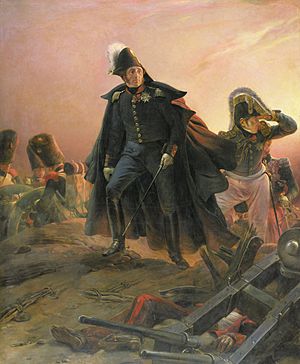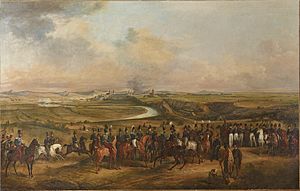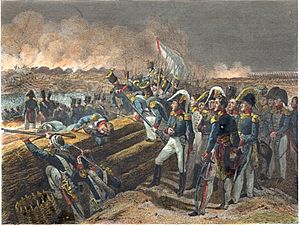Hundred Thousand Sons of Saint Louis facts for kids
Quick facts for kids Hundred Thousand Sons of Saint Louis |
|||||||
|---|---|---|---|---|---|---|---|
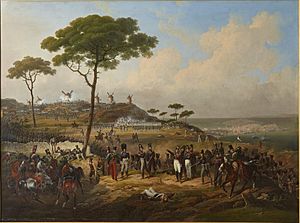 An event from the French help in Spain, 1823, by Hippolyte Lecomte |
|||||||
|
|||||||
| Belligerents | |||||||
| Commanders and leaders | |||||||
|
|
||||||
| Casualties and losses | |||||||
| France: 400 killed | 600 killed | ||||||
The "Hundred Thousand Sons of Saint Louis" was the popular name for a French army. This army was sent to Spain in 1823 by the French King of France, Louis XVIII. Their goal was to help the Spanish royal family, the Bourbons, bring back King Ferdinand VII to full power.
King Ferdinand VII had lost some of his power during a period called the Trienio Liberal (1820-1823). Even though the army was called "Hundred Thousand Sons," there were actually about 60,000 soldiers. This was a smaller military action. The French army was led by the Duke of Angoulême, who was King Louis XVIII's nephew. In France, this event is known as l'Expédition d'Espagne (the "Expedition of Spain").
Contents
Why France Intervened in Spain
In 1822, King Ferdinand VII of Spain wanted to regain his absolute power. He asked other European kings for help. He joined the Holy Alliance, a group formed by Russia, Prussia, Austria, and France. This alliance aimed to bring back absolute rule in countries where kings had lost power.
In France, some powerful royalists wanted their king, Louis XVIII, to step in. They wanted him to stop the spread of liberal ideas from Spain into France. At first, French troops were placed along the Pyrenees Mountains (the border between France and Spain). Their job was to prevent Spanish liberal ideas and a disease called "yellow fever" from entering France. By late 1822, this border watch turned into a military mission.
Europe Discusses Helping Spain
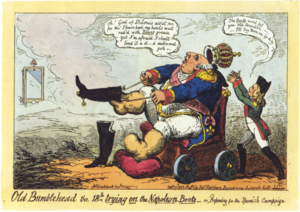
The Holy Alliance (Russia, Austria, and Prussia) first said no to Ferdinand's request for help. However, at a meeting called the Congress of Verona in October 1822, a larger group of countries, the Quintuple Alliance, gave France permission to help Spain. This group included Russia, Britain, France, Prussia, and Austria.
On January 22, 1823, a secret agreement was signed at the Congress of Verona. It allowed France to send troops to Spain to make Ferdinand VII an absolute monarch again. On January 28, 1823, King Louis XVIII of France announced his plan. He said that "a hundred thousand Frenchmen are ready to march" to protect the Spanish throne for Ferdinand VII.
By the end of February, the French Parliament approved money for the mission. Many royalists were happy. They believed the French army would show its bravery and loyalty by fighting for the Bourbon royal family.
The French Prime Minister, Joseph de Villèle, was against the war. He thought it would cost too much money. He also worried that the army was not well-organized and that some soldiers might not be loyal. He needed to make sure the army of 95,000 men, 20,000 horses, and 96 cannons had enough supplies.
The French Army's Setup
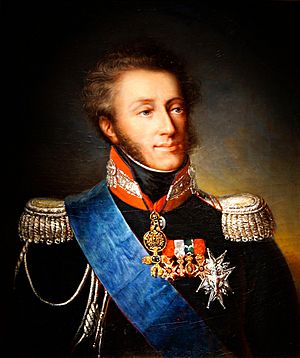
How the Army Was Led
Organizing the army's leadership was tricky. The French king wanted to give important roles to his loyal supporters. But he also needed experienced generals. Many of these generals had fought for Napoleon Bonaparte in the past.
The solution was to give less important commands to royalist supporters. The main commands went to generals who had served during the Revolution and the First Empire. The Duke of Angoulême, the king's nephew, was made the overall commander. However, he mostly handled the political side of the mission. The military decisions were left to Major-General Armand Charles Guilleminot, an experienced general from Napoleon's time.
Most of the army's main groups were led by generals who had fought for Napoleon. These included Marshal Nicolas Charles Oudinot, General Gabriel Jean Joseph Molitor, Marshal Bon Adrien Jeannot de Moncey, and General Étienne Tardif de Pommeroux de Bordesoulle. One group, the Third Corps, was commanded by the Prince of Hohenlohe. This group was smaller and had fewer men.
Soldier Loyalty Concerns
Many officers and soldiers in the French army had fought in the Napoleonic Wars. They had memories of those times. Some were more sympathetic to the liberal ideas than to the French and Spanish royal families. The liberals tried to convince the French soldiers not to fight "for monks, against liberty."
The Prime Minister, Villèle, was worried about this. A popular song by Béranger was spreading. It encouraged French soldiers to refuse to fight. The song went like this:
|
Brav' soldats, v'la l'ord' du jour: |
Brave soldiers, this is the order of the day: |
The Campaign Begins
First Clashes
On April 6, 1823, some French and Italian liberals faced off against French soldiers at the border. They carried a French Tricolour flag and sang La Marseillaise. They tried to convince the soldiers not to cross into Spain. The French soldiers hesitated at first. But General Louis Vallin ordered them to fire. Several of the demonstrators were killed, and the others ran away.
Many of these liberals joined British, Belgian, and other French volunteers. They formed a "liberal legion" to fight alongside the Spanish forces who supported the constitution. The next day, April 7, the "100,000 Sons of Saint Louis" entered Spain. They faced no resistance from the Spanish government's forces. They even had support from many middle-class people and city residents.
French Army Moves Forward
In the north, the French 3rd Corps pushed back General Pablo Morillo's forces. The French gained control of rural areas like Navarre and Galicia. However, they couldn't easily attack the towns. The liberals continued to resist in these towns for several months. For example, the city of A Coruña surrendered on August 21. Pamplona fell on September 16, and San Sebastián on September 27.
In the east and southeast, General Molitor pushed General Francisco Ballesteros back into Aragon. He chased him all the way to Murcia and Granada. Molitor won a battle at Campillo de Arenas on July 28. Ballesteros surrendered on August 4. In Jaén, Molitor defeated the last groups of Rafael Riego. Riego was captured and later hanged in Madrid on November 7. In Catalonia, General Moncey fought against General Mina's forces. Barcelona finally surrendered on November 2.
Battle for Cádiz
The most important fighting happened in Andalusia. This was because Cádiz was located there. Cádiz had become the temporary capital for the Spanish constitutionalists. It was the main target for the French army. The city held the Cortes Generales (the Spanish parliament) and the imprisoned king. It was defended by 14,000 soldiers.
Cádiz was protected by several forts. These included Fort Santa Catalina and Fort San Sebastian to the west. To the east was Fort Santi-Pietri. The most important defense was the fortified area of Fort de Trocadéro. It had 1,700 men and 50 cannons.
French troops, led by General Étienne Tardif de Pommeroux de Bordesoulle and later the Duke of Angoulême, arrived near Cádiz in mid-July. The French navy tried to block the city by sea. But they didn't have enough ships to fully stop supplies from reaching Cádiz.
The End of the Conflict
On August 31, French soldiers attacked Fort de Trocadero. They successfully captured it. This victory cost the French 35 killed and 110 wounded. The Spanish defenders lost 150 killed, 300 wounded, and 1,100 captured. The French then turned the powerful cannons of Trocadero towards Cádiz.
On September 20, Fort Sancti-Petri also fell to a combined army and navy attack. By September 23, cannons from both Trocadero and Sancti-Petri, along with French ships, bombarded Cádiz. On September 28, the constitutionalists realized the city was lost.
The Cortes decided to give back full power to King Ferdinand VII. They handed him over to the French. On September 30, Cádiz surrendered. On October 3, over 4,600 French soldiers landed in the city's port. The last shots of the French army in Spain were fired in early November. On November 5, the Duke of Angoulême left Madrid. He returned to France on November 23. He left behind about 45,000 French soldiers to occupy Spain. The French army slowly left Spain over the next few years, finishing their withdrawal in 1828.
What Happened Next
France's help was very important for King Ferdinand. The liberals had tried to make a deal. They would let Ferdinand return if he promised to follow Spanish laws. However, on October 1, 1823, Ferdinand felt strong because of the French army. He broke his promise. He canceled the Constitution of Cádiz again. He also declared that all actions taken by the liberal government were invalid.
This war also made it harder for Spain to fight the independence movements in Hispanic America. The last Spanish forces in mainland South America were defeated in the Battle of Ayacucho in 1824.
Other Mentions
During the Spanish Civil War in the 1930s, the police force of Republican Spain was sometimes called "The Hundred Thousand Sons of Negrín". This was a reference to the earlier French army.
See also
 In Spanish: Cien Mil Hijos de San Luis para niños
In Spanish: Cien Mil Hijos de San Luis para niños


